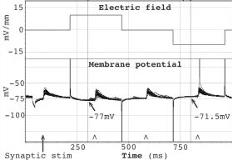MECHANISMS OF ELECTRIC FIELD SUPPRESSION OF NEURONAL ACTIVITY IN A HIPPOCAMPAL SLICE MODEL OF EPILEPSY
Abstract number :
3.155
Submission category :
Year :
2005
Submission ID :
5961
Source :
www.aesnet.org
Presentation date :
12/3/2005 12:00:00 AM
Published date :
Dec 2, 2005, 06:00 AM
Authors :
1Julia Berzhanskaya, 1,2Bruce J. Gluckman, and 1,3Steven J. Schiff
Low frequency ([lt]100Hz), low amplitude ([lt]100mV/mm) electric fields have been adaptively applied to suppress epileptiform activity. Such subthreshold fields modulate neuronal threshold and provide an attractive alternative to high-intensity pulsed stimulation. Nevertheless, the mechanism of interaction of subthreshold fields with principal cells and interneurons remains unknown. Here we explore mechanisms of the electric field effects on hippocampal network activity by recording from visually identified neurons within area CA1 of transverse hippocampal slices using whole cell current-clamp recordings. Electric fields were applied through a voltage-controlled circuit in a custom designed perfusion chamber. Afferent stimulation was used to generate EPSPs and IPSPs, and the morphology of the impaled cells was determined with biocytin histochemistry. The effects of the field depended on the neuron type and morphology. Pyramidal cells were consistently depolarized by a negative electric field aligned with the somato-dendritic axis, and hyperpolarized by a positive electric field. Interneurons showed a diverse response to weak electric fields. Some interneurons demonstrated no effect when a similar stimulation caused significant polarization in pyramidal cells. Others had the same sign polarization as in pyramidal cells, though more typically of smaller amplitude. The effect of the field on evoked EPSPs varied from cell to cell and was determined by a combination of changes in the transmembrane driving force for synaptic channels and voltage-gated membrane conductances as determined by dendritic tree morphology. Negative electric fields also decreased spike latency and increased the number of spikes. Effects of electric fields on membrane potential and spontaneous activity had a composite time course consisting of medium (tens of milliseconds) and slow (few seconds) phases. A complex interplay between the polarization effects on interneurons and pyramidal cells determines the effect of electric fields on network excitability.[figure1] (Supported by NIH R01MH50006, K02MH01493.)
